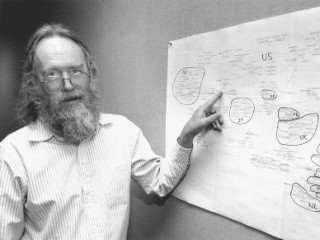
Jon Postel biography
Date of birth : 1943-08-06
Date of death : 1998-10-16
Birthplace : Altadena, California,U.S.
Nationality : American
Category : Science and Technology
Last modified : 2011-12-17
Credited as : computer scientist, contributions to the development of the Internet, Editor of the Request for Comment
0 votes so far
Postel attended UCLA where he earned his B.S. (1966) as well as his M.A. (1968) in Engineering. Attending UCLA, he completed his Ph.D. in Computer Science in 1974. His PhD. thesis advisor was Dave Farber.
While at UCLA, he was involved in early work on the ARPANET. He worked briefly at Mitre Corporation, then helped set up the Network Information Center at SRI. In March 1977 he joined the Information Sciences Institute at the University of Southern California, where he spent the rest of his career.
Postel was the RFC Editor from 1969 until his death, and wrote and edited many important RFCs, including RFC 791, RFC 792 and RFC 793, which define the basic protocols of the Internet protocol suite, and RFC 2223, Instructions to RFC Authors. He wrote or co-authored more than 200 RFCs.
Postel served on the Internet Architecture Board and its predecessors for many years. He was the Director of the names and number assignment clearinghouse, the Internet Assigned Numbers Authority (IANA), from its inception. He was the first member of the Internet Society, and was on the Board of Trustees of the Internet Society. He was the original and long-time .us Top-Level Domain administrator. He also managed the Los Nettos Network.
All of the above were part-time activities he assumed in conjunction with his primary position as Director of the Computer Networks Division ("Division 7") of the Information Sciences Institute at the University of Southern California.On January 28, 1998, Postel, as a test, emailed eight of the twelve operators of Internet's regional root nameservers on his own authority and instructed them to change the root zone server from then SAIC subsidiary Network Solutions. The operators complied with Postel's instructions, thus dividing control of Internet naming between IANA and the four remaining U.S. Government roots at NASA, DoD, BRL and NSI. Though usage of the Internet was not interrupted, he soon received orders from senior government officials to undo this change, which he did. Within a week, the US NTIA issued A proposal to improve technical management of Internet names and addresses, including changes to authority over the Internet DNS root zone, which ultimately, and controversially, increased U.S. control.
On October 16, 1998, Postel died of complications after heart valve replacement surgery in Los Angeles, nine months after the DNS Root Authority incident.
The significance of Jon Postel's contributions to building the Internet, both technical and personal, were such that a memorial recollection of his life forms part of the core technical literature sequence of the Internet in the form of RFC 2468 "I Remember IANA", written by Vinton Cerf. (This is no trivial thing given that between April 1969 and October 2010, only 6,044 RFCs were published).
Perhaps his most famous legacy is from RFC 793, which includes a Robustness Principle which is often labeled Postel's Law: "be conservative in what you do, be liberal in what you accept from others" (often reworded as "be conservative in what you send, liberal in what you accept").In digital circuits, this principle has long been an important aspect of what is known as the static discipline.
















